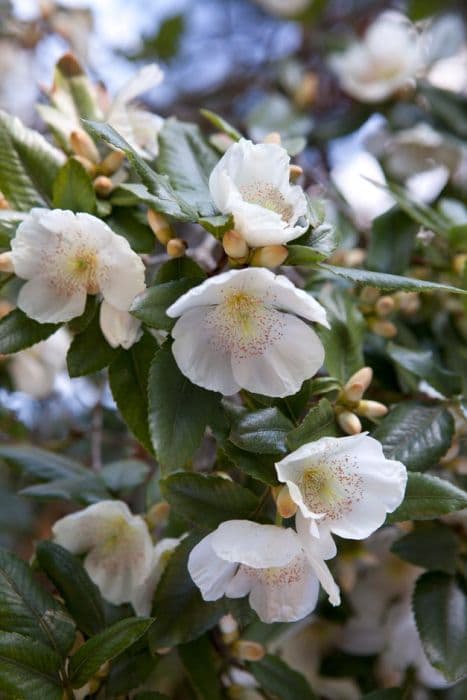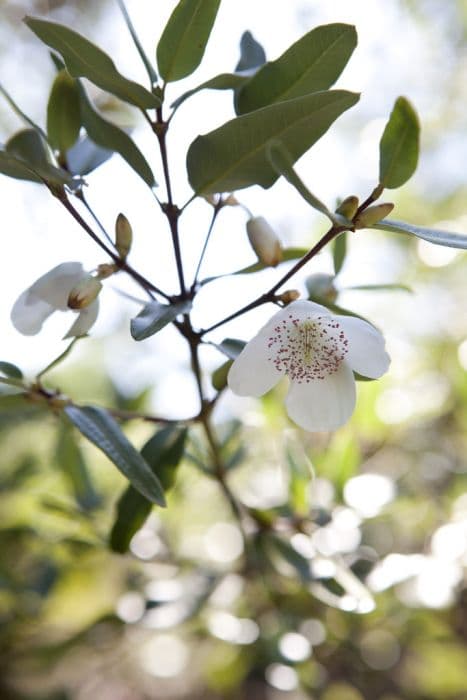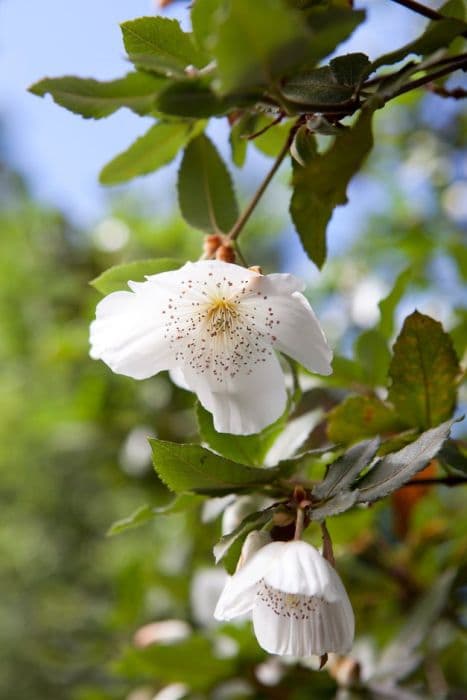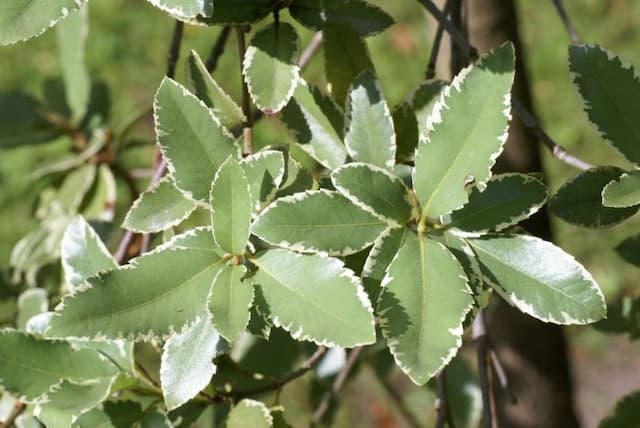Brush bush Eucryphia glutinosa

ABOUT
The plant known commonly as the Brush Bush is an attractive evergreen noted for its glossy, dark green leaves which are broad, leathery, and often have wavy edges. These leaves are arranged alternately on the branches, creating a rich, dense foliage that can be quite striking. During the blooming period, the Brush Bush produces an abundance of white flowers that are particularly eye-catching. These flowers have a cup-like shape and are generally large, with a cluster of conspicuous yellow stamens at their center, giving a bright and contrasting appearance against the dark foliage. The petals are known for being very showy, which makes the plant a popular choice for ornamental purposes. The overall appearance of the Brush Bush is lush and vibrant, with the glossy leaves and white flowers contributing to its appeal as a ornamental plant for gardens and parks.
About this plant
 Names
NamesFamily
Cunoniaceae
Synonyms
Brush Bush, Leatherwood, Eucryphia
Common names
Eucryphia cordifolia, Eucryphia pinnatifolia, Eucryphia glutinosa var. cordifolia
 Toxicity
ToxicityTo humans
Eucryphia glutinosa, commonly known as the Leatherwood, is not widely recognized for its toxicity to humans. There is limited information regarding its potential poisonous attributes, and it is not typically listed among plants known for having toxic effects when ingested by humans. Therefore, no specific symptoms of poisoning can be provided for this plant. However, as with any plant, it is advisable to exercise caution and avoid ingesting parts of plants not known to be safe for human consumption.
To pets
Eucryphia glutinosa, known as the Leatherwood, does not have a well-documented profile for toxicity in pets such as dogs and cats. There is limited evidence suggesting that it is harmful to domestic animals. Consequently, there are no specific symptoms of poisoning associated with this plant for pets. Nevertheless, it's generally recommended to prevent pets from ingesting plants that are not confirmed to be safe. If you suspect your pet has ingested any part of a plant and is showing signs of illness, it's important to contact a veterinarian.
 Characteristics
CharacteristicsLife cycle
Perennials
Foliage type
Evergreen
Color of leaves
Green
Flower color
White
Height
15 feet [4.57 meters]
Spread
10 feet [3.05 meters]
Plant type
Tree
Hardiness zones
7
Native area
South America
Benefits
 General Benefits
General Benefits- Ornamental Value: Eucryphia glutinosa, commonly known as the Chilean eucryphia, is often prized for its attractive flowers and tall, columnar form which add aesthetic value to gardens and landscapes.
- Habitat for Wildlife: The plant can provide food and shelter for various species of birds, bees, and butterflies, thereby supporting local biodiversity.
- Shade Provider: With its tall and dense canopy, the Chilean eucryphia can offer a significant amount of shade, making it useful for planting in parks or large gardens.
- Windbreak: In windy areas, Chilean eucryphia trees can act as windbreaks, protecting smaller plants and reducing soil erosion.
- Timber Source: Although not its primary use, the wood of Eucryphia glutinosa can be used in the timber industry for the production of furniture and crafts when cultivated sustainably.
 Medical Properties
Medical PropertiesThis plant is not used for medical purposes.
 Air-purifying Qualities
Air-purifying QualitiesThis plant is not specifically known for air purifying qualities.
 Other Uses
Other Uses- Floral Arrangements: The Eucryphia glutinosa, also known as the Brush Bush, produces attractive flowers that can be used in floral arrangements and bouquets for decorative purposes.
- Honey Production: The flowers of the Brush Bush are a source of nectar for bees, which can produce a distinctive type of honey that may be valued for its unique flavor.
- Garden Specimen: Brush Bush can serve as an ornamental feature in gardens due to its striking flowers and foliage, thereby enhancing the aesthetic appeal of outdoor spaces.
- Artistic Inspiration: The beauty of the Brush Bush can inspire artists and photographers, who may use the plant as a subject in their work to capture its natural appeal.
- Educational Tool: Botanists and educators may use the Brush Bush in educational settings to teach about plant biology, pollination, and ecological interactions.
- Eco-friendly Dye: The bark or leaves of the Brush Bush can potentially be used to create natural dyes for fabric or craft projects, offering an eco-friendly alternative to synthetic dyes.
- Privacy Screening: When grown in groups or as hedges, the dense foliage of the Brush Bush can provide privacy screening for homes and gardens.
- Cultural Symbolism: In some cultures, plants like the Brush Bush might hold symbolic meanings and be used in ceremonies or cultural events.
- Woodcraft: The wood from Eucryphia glutinosa trees can be used in woodturning or carving to create small objects or decorative items.
- Companion Planting: The Brush Bush may be used in companion planting schemes to attract pollinators that benefit other nearby plants in the garden or agricultural settings.
Interesting Facts
 Feng Shui
Feng ShuiThe Eucryphia glutinosa is not used in Feng Shui practice.
 Plant Symbolism
Plant Symbolism- Endurance: Eucryphia glutinosa, commonly known as the Leatherwood, is renowned for its hardy nature and ability to thrive in various conditions, which makes it a symbol of endurance and resilience.
- Rarity and uniqueness: Leatherwood is not as widely recognized or found as some other plants, symbolizing uniqueness and the beauty of rare entities in our lives.
- Adaptability: As it can adapt to different soil types and environments, Leatherwood represents the ability to adjust to changing circumstances and the importance of flexibility.
- Everlasting bonds: The strong wood and persistent nature of Leatherwood make it a symbol of strong, lasting relationships and unbreakable bonds.
- Purity: With its bright flowers, Leatherwood is often associated with purity and innocence.
 Water
WaterThe Leatherwood should be watered thoroughly, allowing the soil to become moderately dry between waterings. It prefers a consistently moist environment, so during the growing season, it's typically necessary to water once every week, applying approximately 1 to 1.5 gallons per watering session for mature plants, depending on climate and soil drainage. In hot or windy weather, the plant may require more frequent watering to keep the soil from drying out completely, while in cooler weather or when it is not actively growing, reduce watering frequency to prevent waterlogging.
 Light
LightLeatherwood thrives best in full sun to partial shade. Ideally, the plant should receive at least six hours of sunlight daily, though it can also tolerate dappled sunlight. The perfect spot would be one where it's protected from the intense afternoon sun, which can be too harsh, especially in hotter climates.
 Temperature
TemperatureLeatherwood plants are hardy and can handle a temperature range from approximately 20°F to 80°F. They prefer a temperate climate with mild summers and cool winters. The ideal temperature range for promoting vigorous growth and blooming is between 60°F and 70°F.
 Pruning
PruningPruning the Leatherwood is primarily for shaping and removing any dead or damaged branches. It's best to prune in late winter or early spring, before the new growth starts. Pruning every two to three years is generally adequate to maintain a healthy and aesthetically pleasing form.
 Cleaning
CleaningAs needed
 Soil
SoilFor the Leatherwood (Eucryphia glutinosa), a well-draining acidic soil mix is ideal. Aim for a pH between 5.5 to 6.5. You can create a suitable mix using equal parts of peat, pine bark, and perlite or coarse sand to facilitate good drainage and meet its preference for acidic conditions.
 Repotting
RepottingLeatherwoods (Eucryphia glutinosa) should be repotted every 2 to 3 years, or when they outgrow their current container. It's best to repot in the spring before new growth begins.
 Humidity & Misting
Humidity & MistingLeatherwood (Eucryphia glutinosa) thrives in moderate to high humidity levels, ideally between 60% to 80%. This plant will benefit from a humid environment, reflecting its natural habitat.
 Suitable locations
Suitable locationsIndoor
Place Leatherwood near a bright window, away from direct sun.
Outdoor
Plant Leatherwood in dappled light and sheltered from strong winds.
Hardiness zone
8-10 USDA
 Life cycle
Life cycleEucryphia glutinosa, commonly known as the Brush Bush, begins its life cycle as a seed, which after dispersal, typically through wind or animal activity, finds suitable soil to germinate. During germination, the seed absorbs water and begins to sprout, developing a root system and a shoot that grows towards the light. The Brush Bush then enters the seedling stage, where it continues to establish its roots and shoots, eventually growing into a young plant with characteristic leaves and stems. As it matures, the Brush Bush enters the vegetative stage, where it experiences significant growth and branching, developing a sturdy structure capable of supporting flowers. Upon reaching the flowering stage, the Brush Bush produces blooms, which, if pollinated, develop into fruit containing seeds, thus completing the reproductive cycle. Following seed set, the plant may enter a period of dormancy, especially in cooler climates, to conserve energy before resuming growth in the next appropriate season, ensuring the continuity of the species.
 Propogation
PropogationPropogation time
Spring-summer
Eucryphia glutinosa, commonly known as the Chilean eucryphia or leatherwood, is most commonly propagated by semi-hardwood cuttings. The ideal time to take these cuttings is in late summer. To propagate by this method, select a healthy, semi-hardwood stem that is about 4 to 6 inches (10 to 15 centimeters) long. The base of the cutting should be cut just below a leaf node, and the lower leaves should be removed. Dipping the cut end in rooting hormone can enhance root development. The cutting should then be planted in a well-draining potting mix and kept moist but not waterlogged. Covering the pot with a plastic bag can help maintain humidity levels, which is beneficial for root growth. With proper care, roots should develop within a few weeks, after which the new plant can be gradually acclimated to ambient conditions before transplanting.









